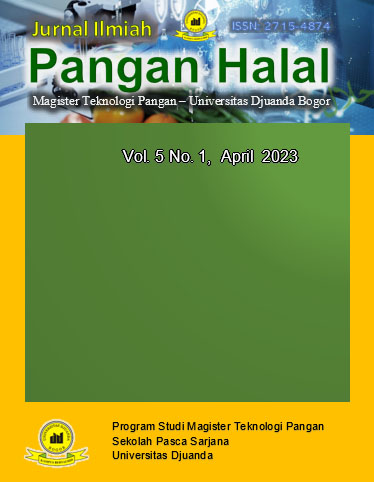Inovasi Lip Balm Berbasis Madu: Pembuatan, Karakterisasi, dan Potensi Aplikasi
Main Article Content
Abstract
Lip balm is a lip care product to maintain the moisture and health of the lips. Innovations in the cosmetic industry are currently leading to the use of natural ingredients. Honey as a natural ingredient has the potential to be the main ingredient in lip balm. The idea of this research is to produce an innovative honey-based lip balm through the proper manufacturing method, physical and chemical characteristics, and evaluation of its application potential. The method of making lip balm involves honey extraction, formulation with additional ingredients such as vegetable oils, and beeswax, and the use of natural preservatives. At the characterization stage, the resulting lip balm is analyzed to determine its physical properties such as texture, color, and moisture. Chemical analysis was also carried out to evaluate the nutritional content and active compounds in honey-based lip balms. The results of the article review show that honey-based lip balm has a soft texture, and attractive color, and is able to keep the lips moist for quite a long time. Chemical analysis revealed that this honey lip balm contains active compounds such as antioxidants and enzymes which are useful in treating and protecting lips from damage as a result of environmental effects. The potential application of this honey-based lip balm innovation functions as a moisturizer and care for dry lips, protection from the sun, and relieves irritation and inflammation of the lips.
Article Details

This work is licensed under a Creative Commons Attribution-NonCommercial-ShareAlike 4.0 International License.
References
Ainaro, E. P., Gadri, A., & Priani, S. E. (2015). Formulasi Sediaan Masker Gel Peel-Off Mengandung Lendir Bekicot (Achatina Fulica Bowdich) sebagai Pelembab Kulit. Prosiding Farmasi, 86-95.
Ayubi, A. N. (2018) ‘Analysis Of Total Reducing Sugar Content, Acidity Value, And Hydroxymethylfurfural (HMF) Content Of Various Honey Types’, Indonesian Journal Of Chemistry And Environment, 1(1), Pp. 21–28. Doi: 10.21831/Ijce.V1i1.20786.
Budiono, N. L. A., Dewi, Y., Lestari, D. A., Dinita, S. T., Izzah, I. N. L., & Gunarti, N. S. (2022). Formulasi Madu Dalam Sediaan Kosmetik: Review Journal. Jurnal Buana Farma, 2(4), 31-37.
Dominica, D., Sari, D. K., Handayani, D., Zulkarnain, D., Simanjuntak, A. T., Khairunisah, D., & Shufyani, F. (2023). Formulasi Pelembab Bibir Alami Dari Sari Buah Jeruk Kalamansi (Citrofortunella Microcarpa) Dan Ekstrak Bunga Rosella (Hibiscus sabdariffa). Journal of Pharmaceutical and Sciences, 6(1), 26-36.
Evahelda (2017) ‘Sifat Fisik Dan Kimia Madu Dari Nektar Pohon Karet Di Kabupaten
Bangka Tengah , Indonesia Physical And Chemical Characteristics Of Honey From Rubber Tree Nectar In Central Bangka Regency , Indonesia’, Agritech, 37(4), Pp. 363–368.
Hudri, F. A. (2014). Uji efektivitas ekstrak madu multiflora dalam menghambat pertumbuhan bakteri salmonella typhi.
Jumiono, A., & Rahmawati, S. I. (2020). Kriteria Sertifikasi Halal Barang Gunaan Di Indonesia. Jurnal Ilmiah Pangan Halal, 2(1), 10-16.
Jumiono, A., Widowati, S., Fitrilia, T., Kaniawatii, R., & Indriyani, D. P. (2022, May). Dietetic Food Products Based on Pumpkin Flour (Curcuma Moschata). In IOP Conference Series: Earth and Environmental Science (Vol. 1024, No. 1, p. 012046). IOP Publishing.
Kartiko, H. ., & Fanani, M. Z. . (2021). Pengaruh Perbedaan Waktu dan Suhu Pengeringan Terhadap Aktivitas Antioksidan Teh Herbal Daun Kelapa Sawit dengan Metode Oven-Dried. Jurnal Ilmiah Pangan Halal, 3(2), 13–15.
Oktaria, S., Yanti, S., & Densi, S. S. (2020). Formulasi Sediaan Lip Balm Dari Gel Lidah Buaya (Aloe vera (L). Burm. J.) (Doctoral dissertation, Stikes Al-Fatah Bengkulu).
Putri, S. L. (2017). Analisis Preferensi Konsumen Terhadap Pemilihan Kosmetik Lipstik (Doctoral Dissertation, Universitas Negeri Jakarta).
Suhandy, D., Yulia, M. And Kusumiyati, K. (2020) ‘Klasifikasi Madu Berdasarkan Jenis Lebah (Apis Dorsata Versus Apis Mellifera) Menggunakan Spektroskopi Ultraviolet Dan Kemometrika’, Jurnal Ilmu Pertanian Indonesia, 25(4), Pp. 564–573. Doi: 10.18343/Jipi.25.4.564.
